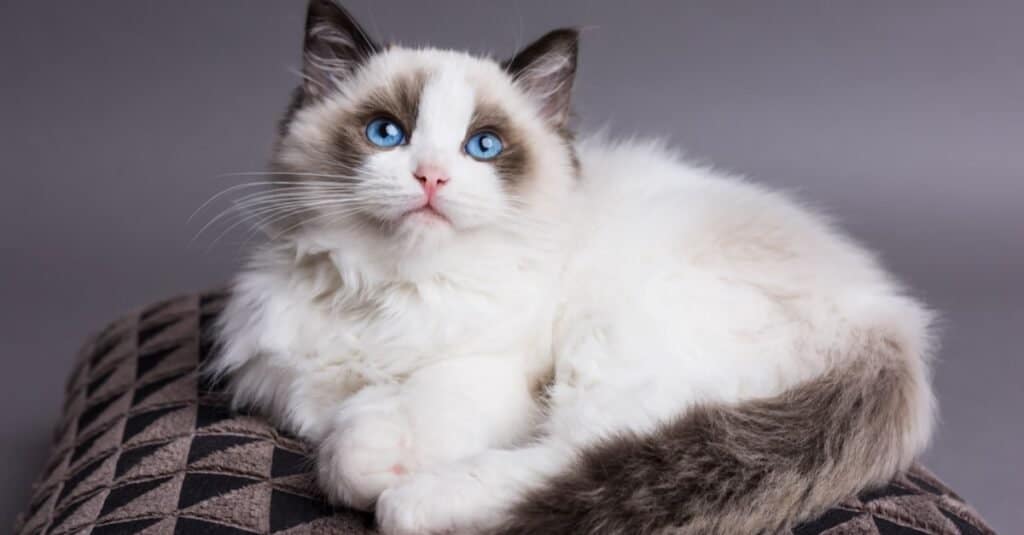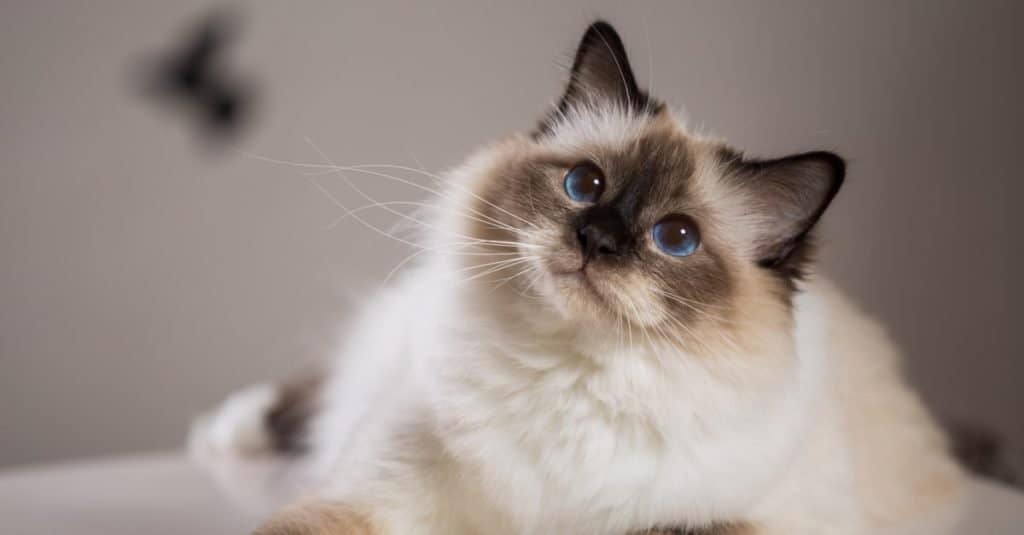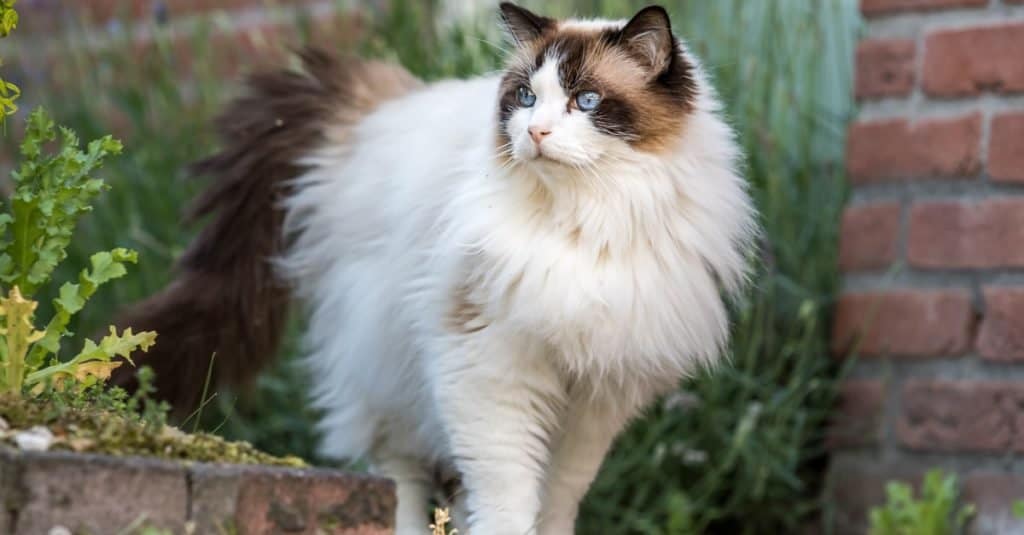Some people may mistake Birman cats for Ragdoll cats or vice versa, although this is not their fault. Blue eyes and long-haired, color-pointed coats characterize both breeds. There are, however, some distinctions between them. The Ragdoll has plushy fur, while Birman cats have silky ones with almost no undercoat. It’s sometimes difficult to tell the difference by looking, but it’s simple to recognize it when you fondle each cat. The size difference is likely the most significant. A Ragdoll is huge, weighing up to 20 pounds, while a Birman is a medium-sized cat that only weighs about 12 pounds. Aside from these, what further differences exist between Birmans vs Ragdolls? Below, we will explore the key features that set the two cats apart.
Comparing a Birman and a Ragdoll

| Birman | Ragdoll | |
| Height | – averages from 8-10 inches | – averages from 17-21 inches |
| Weight | – can weigh up to 10-12 pounds, depending on diet | – can weigh up to 8-20 pounds, depending on diet |
| Chins | – colored chins | – all have white chins, especially if mitted |
| Coats | – silky and thinner, almost no undercoat | – soft and plushy fur, similar to a rabbit’s |
| Personality | – more active and likely to be better companions with other pets | – more tolerant and clingy |
| Grooming | – once or twice a week, but it’s easier since they have thinner coats | – once or twice a week, and daily brushing |
The 5 Key Differences Between a Birman and a Ragdoll
The main differences between a Birman and a Ragdoll include their size, chins, coats, personalities, and grooming requirements. It’s not easy to choose between a Birman and a Ragdoll as both of them are cute and make excellent pets.
The Birman cat originated in Burma, where priests raised them in temples hundreds of years ago. In the 1920s, they sold them to France, and they have since spread globally. The Ragdoll, however, is less intriguing. It was developed in the 1960s by deliberately breeding a unique Persian cat to produce characteristics similar to those in the normal Ragdoll. The actual origins remain a mystery. At first glance, it is easy to confuse these two cats. But once you get to spend some time with them, you begin to notice their significant variations. Hence, we’ll go through the differences between these two felines in detail.
Birman vs Ragdoll: Height and Weight

Ragdoll cats are larger than Birman cats.
©madeinitaly4k/Shutterstock.com
Ragdoll cats, which are among the biggest domesticated cat breeds, are larger than Birmans. Adult male Ragdolls weigh 15 to 20 pounds, whereas adult female Ragdolls weigh 8 to 15 pounds. They stand around 17-21 inches, and because of their natural big size, these cats take four years to reach their maximum size. The bodies of Ragdolls are also more muscular than Birmans.
The Birman cats are known as medium-sized cats. As adults, they can weigh anywhere from six to twelve pounds. It is not uncommon for adult male Birman cats to outweigh females by a few pounds, and most of them grow to about 8 inches tall. In addition, it can only take up to three years for this cat breed to reach full maturity.
Birman vs Ragdoll: Chins
The Ragdoll, like the Birman, may also have white gloves! So how do you tell them apart? If you have an adult Birman and an adult Ragdoll together, you will notice the chin of a Ragdoll is white, while Birmans do not have this feature. The Birman, therefore, will have a colored chin. When the Ragdoll is mitted, its chin should also be white. The mitted Ragdoll must have a white band going from its chin, through its belly, and up to the tail. Some Ragdolls can also have a distinct white mark on their nose.
The Birman’s white gloving mutation is present in some Ragdolls but not all, implying that another genetic mechanism is responsible for the Ragdoll’s white mitted pattern.
Birman vs Ragdoll: Coats

Compared to the Ragdoll, Birman cats have silkier and thinner coats.
©Borkin Vadim/Shutterstock.com
The Birman cat has a silkier and thinner coat. Contrary to popular belief, the Birman is not a hypoallergenic cat breed. It means that the Birman cat lacks an insulating undercoat, which only leads to moderate shedding. The Birman cat coat is also less susceptible to matting or tangling. Plus, theirs has only one pattern: pointed, in seal and chocolate brown, blue-gray, light gray, red, cream, or tortoiseshell-colored markings on their face, legs, and tail.
The Ragdoll, on the other hand, has soft and plushy fur. Although these big, long-haired cats lack a full insulating undercoat, their topcoat is thick and can shed profusely, particularly as the seasons change. They have four different marking patterns: colorpoint, mitted, van, and bicolor. While mitted ragdolls have the same colored points as Birmans and have white markings on their feet and legs, they also have white chins.
Birman vs Ragdoll: Personality

Birmans are more active than Ragdolls.
©Serita Vossen/Shutterstock.com
Birman and Ragdoll cats are both bred to be companion cats. Birmans have a long history of serving as companions because they are affectionate and loving, and they make fantastic family pets. Although these cats are laid-back pets, they are nonetheless relatively active.
In contrast, Ragdoll cats are sluggish. They flop like a ragdoll whenever someone picks them up. Their favorite pastime is relaxing, but these gorgeous cats also adore their humans and, surprisingly, other cats. Both cat breeds have similar personalities, although Ragdolls are more tolerant and clingy than Birmans, so they are suitable for families.
Birman vs Ragdoll: Grooming
Both cats require grooming, although, contrary to popular belief, neither of these breeds needs high maintenance. While they may be furry cats, their coats are unlikely to tangle and mat due to their lack of undercoat. Birmans, however, are easier to groom than Ragdolls because they are smaller and have a thinner coat.
The Ragdoll cat can shed a lot, and the fact that this cat breed has long, silky hair can make shedding appear even worse than it is. Regularly brushing, combing, and grooming them will help you eliminate mats and tangles, as well as minimize shedding.
The photo featured at the top of this post is © Ariele / Creative Commons / Original
Thank you for reading! Have some feedback for us? Contact the AZ Animals editorial team.






